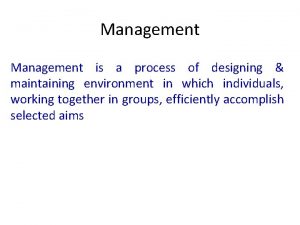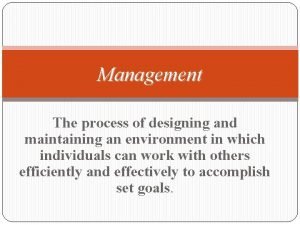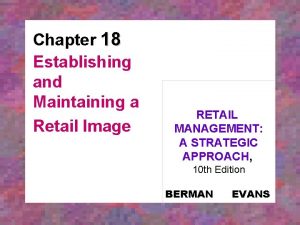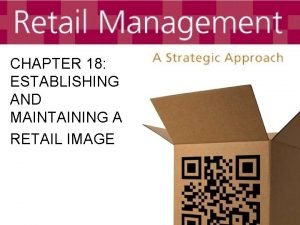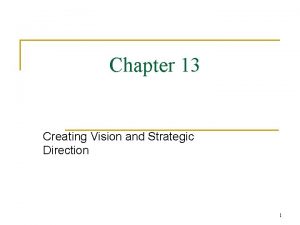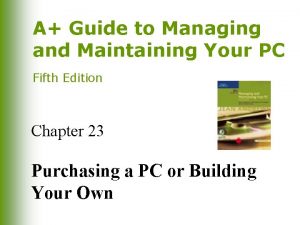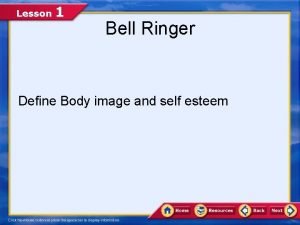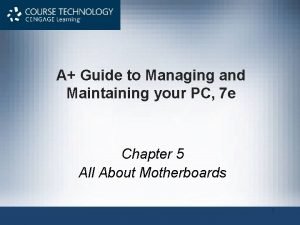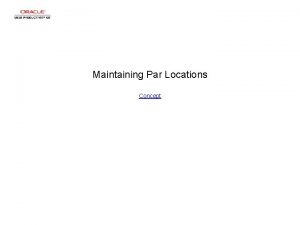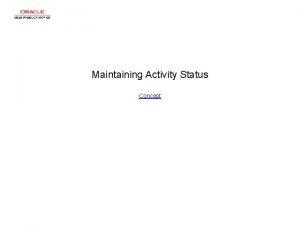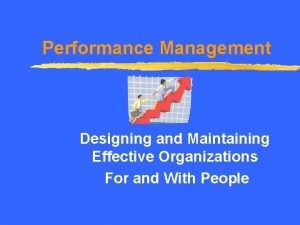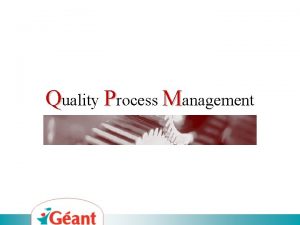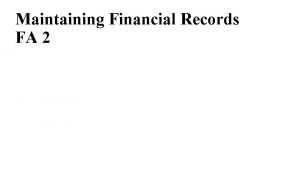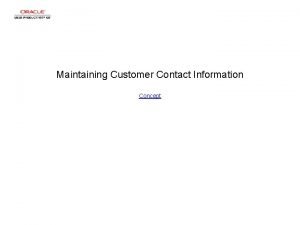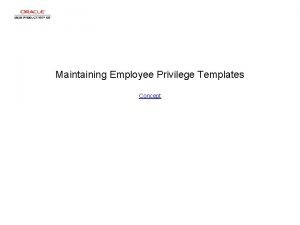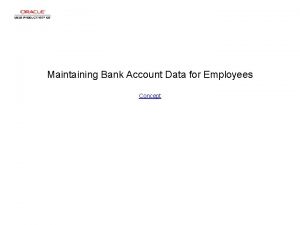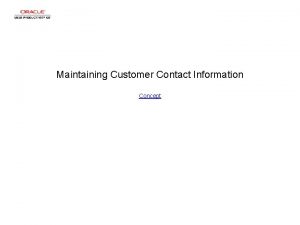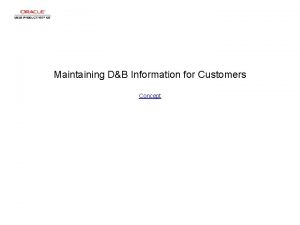Management The process of designing and maintaining an




























- Slides: 28

Management The process of designing and maintaining an environment in which individuals can work with others efficiently and effectively to accomplish set goals.

What is Management? Science and an art Interacting with people to achieve results Using resources to achieve objectives Balancing tradeoffs

Manger’s Roles in the Cooperative Figurehead – public face of the cooperative Leader – makes decisions and leads employee group Liason – gateway between board and employees Recipient-- receives information from board, employees and members Disseminator-- issues information to board, employees and members Spokesperson -- represents co-op externally Entrepreneur-- calculated risk taker Disturbance handler-handles disputes between employees and members Resource allocator-develops budgets and assigns personnel Negotiator-bargains with suppliers and buyers

Management Skills Technical and operational Financial Human resource management Planning and project management Critical thinking and decision making

FUNCTIONS OF MANAGEMENT Planning Organizing Directing Staffing Controlling Coordination Social & ethical responsibilities

Goals of the Cooperative Manager To run an efficient operation To manage and build human resources To collaborate with the board of directors To create a profit To plan for and protect the future viability of the cooperative To distribute benefits to members through service, patronage and revolving equity

Is Managing a Cooperative Different? Closer, more long-term relationship with customers Must weigh trade-offs between member’s realized return and financial well being of cooperative More political, more emphasis on communication Possibly, a greater emphasis on ethics More complex objective function since members benefit from market access, price, patronage, revolving equity and risk pooling

Adjusting Decision Making When the Customers are Owners also receive returns through transactions Maximizing ROE is not the only objective Guaranteeing a market or supply is also important Customers have long-term relationship with firm and manager

Distributing Net Earnings is Much More Complex Single or multiple patronage pools Retaining earnings as unallocated reserves Distributing in cash, qualified stock or non-qualified stock Inter-related with balance sheet management, equity retirement and infrastructure investment

Cooperative Manager Works in A Spotlight Owners evaluate the cooperative with every transaction Customer/owners express opinions directly to the manager Decision on product line, inventory, hours of operation and seasonal locations may be more political Cooperative manager is more likely to have a hands-on role in local operations

Cooperative Business Model Has Different Control and Incentive Cooperative manager does not gain stock options or ownership Cooperative manager has to respond to the majority of the ownership not just the major stockholders Management styles from investor owned firms may not be successful in a cooperative The goal (objective function) of a cooperative is more complex

Four and ½ Ways Members Benefit Favorable Prices Patronage Refunds (cash and stock) Services Provided Dividends on invested capital (not as common) Increased Competitive Environment

Favorable Prices Immediate benefit popular with young members Problems for manager Miss estimate costs and generate a loss Cannot generate equity Benefit not realized by members Competition reacts benefiting non-members Distorts the value of investing in the cooperative since there is low ROE

Dividends on Invested Equity May be limited by state or federal statute Often is set at zero Would increase willingness to invest and/or maintain long revolving cycle Popular with heavily invested members who may not be using the cooperative Competes with the ability to provide funds to users through patronage refunds

Patronage Refunds Fundamental cooperative principle and method of creating equity No relation to invested capital Provided in stock and cash-members always prefer the immediate benefit of cash Conflict arises in redeeming previously issued stock refunds since it competes for the cash needed to pay current refunds

Services Provided A common rationale for establishing a cooperative Other firms may not provide the service or provide it at competitive prices Cooperative may be a better position to understand customer needs Conflict in multi-product or multi-service cooperatives when one product or service is being subsidized by others

Increased Competitive Environment Invisible benefit of cooperatives Problem is that it is often not recognized until the cooperative disappears Half a benefit because it also is available to non users

How do members exercise control in a cooperative Voicing opinions to board and manager Voting to elect directors Occasionally voting on big issues involving structural change Voting with their feet (discontinue using the cooperative) Democratic process should not interfere with good business decisions but may require more communication

The Cooperative Management Dilemma Do we operate as a membership organization? Do we operate as a business enterprise? The manager should operate as an efficient business organization but they must realize the inherent differences that arise when most customers are also owner and who expect to have frequent opportunities to provide input to the manager.

The following slides have examples of cooperative management activities involving: People Capital Planning Decision making Commodity marketing Farm supply Activities in larger cooperatives Other

Cooperative Manager-People Manager involved in customer relations Two way communication with customer/members Educating members about the cooperative Relationship with lender Relationship with regional cooperatives Frequent contact with board members

Cooperative Manager: Capital Cooperative board and manager must actively manage the balance sheet Inherent tradeoff between member’s realized return and liquidity of the cooperative Distributions of returns are complex

Cooperative Manager Role: Planning Operating budgets must be prepared each year Fixed asset replacement budget Harvest and fertilizer season preparation Formal or informal feasibility studies Most cooperatives have one or more on-going infrastructure replacement projects at all times

Cooperative Manager Role Marketing Assembling or owning trucks, rail arrangements Pricing products and establishing margins Establishing and monitoring contracts with members Establishing grain storage policies Monitoring stored product management

Cooperative Manager Role-Farm Supply Determining market potential and forecasting needs Purchasing supplies Managing inventories Pricing supplies Establishing and monitoring credit Providing custom and technical services Providing information to patrons

Cooperative Manager Role: Larger Cooperatives Establishing departments and branch operations Developing a management team Managing a large employee team Communicating with a large number of members over a wide geographic area Establishing fair operating policies across branches Evaluating and participating in JVs and Alliances

Cooperative Manager Role: Other Understanding and complying with requirements of government agencies and regulators Evaluating mergers and acquisitions Participating in industry organizations Continuing to learn about the competitive environment and innovative strategies

Questions?
 The process of designing and maintaining an environment
The process of designing and maintaining an environment The process of designing and maintaining an environment
The process of designing and maintaining an environment Process of textbook designing and development
Process of textbook designing and development Product vs process layout
Product vs process layout The main issue in designing process layouts concerns what?
The main issue in designing process layouts concerns what? Principles of records and reports
Principles of records and reports Building and maintaining a website
Building and maintaining a website Cleaning equipment for crockery
Cleaning equipment for crockery Disadvantages of straight traffic pattern
Disadvantages of straight traffic pattern Straight traffic pattern
Straight traffic pattern Interior pressure sensor chapter 17
Interior pressure sensor chapter 17 Maintaining a healthy body composition and body image
Maintaining a healthy body composition and body image Creating vision and strategic direction
Creating vision and strategic direction Purchasing and maintaining a computer
Purchasing and maintaining a computer Maintaining a healthy body composition and body image
Maintaining a healthy body composition and body image Building and maintaining customer relationships
Building and maintaining customer relationships Maintaining a healthy body composition and body image quiz
Maintaining a healthy body composition and body image quiz Maintaining a healthy body composition and body image
Maintaining a healthy body composition and body image Guide to managing and maintaining your pc
Guide to managing and maintaining your pc Guide to managing and maintaining your pc
Guide to managing and maintaining your pc Guide to managing and maintaining your pc
Guide to managing and maintaining your pc How to keep your deliverance
How to keep your deliverance Maintaining a professional image
Maintaining a professional image Class-maintaining prefixes examples
Class-maintaining prefixes examples Chapter 15:3 washing hands
Chapter 15:3 washing hands An eating disorder in which people overeat compulsively
An eating disorder in which people overeat compulsively Potential tension between maintaining confidentiality
Potential tension between maintaining confidentiality Maintaining a teachable spirit
Maintaining a teachable spirit Maintaining a website
Maintaining a website
